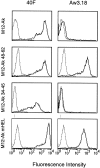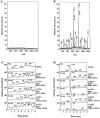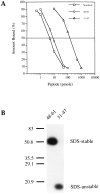Rous-Whipple Award Lecture. Chemical features of peptide selection by the class II histocompatibility molecules
- PMID: 10079241
- PMCID: PMC1866414
- DOI: 10.1016/s0002-9440(10)65311-4
Rous-Whipple Award Lecture. Chemical features of peptide selection by the class II histocompatibility molecules
Figures









Similar articles
-
Rules for peptide presentation by MHC class II molecules.Int Rev Immunol. 1993;10(4):301-11. doi: 10.3109/08830189309061705. Int Rev Immunol. 1993. PMID: 8294843 Review. No abstract available.
-
Structure of peptides associated with class I and class II MHC molecules.Annu Rev Immunol. 1994;12:181-207. doi: 10.1146/annurev.iy.12.040194.001145. Annu Rev Immunol. 1994. PMID: 7516668 Review.
-
Interactions between peptides and major histocompatibility complex molecules during antigen processing and presentation.Chem Immunol. 1993;57:63-87. Chem Immunol. 1993. PMID: 8260090 Review. No abstract available.
-
T-splenocytes from non-obese diabetic mice binding to xenogeneic pancreatic beta-cells in vitro. Implication of the alpha/beta T-cell receptor and of major histocompatibility complex class II molecules from target cells.J Autoimmun. 1993 Dec;6(6):753-69. doi: 10.1006/jaut.1993.1062. J Autoimmun. 1993. PMID: 8155255
-
Antigen presentation in the autoimmune diabetes of the NOD mouse.Annu Rev Immunol. 2014;32:579-608. doi: 10.1146/annurev-immunol-032712-095941. Epub 2014 Feb 5. Annu Rev Immunol. 2014. PMID: 24499272 Review.
References
-
- Unanue ER, Allen PM: The basis for the immunoregulatory role of macrophages and other accessory cells. Science 1987, 236:551-557 - PubMed
-
- Unanue ER: Studies in Listeriosis show the strong symbiosis between the innate cellular system and the T cell response. Immunol Rev 1997, 158:11-25 - PubMed
-
- Lenschow DJ, Walunas TL, Bluestone JA: CD28/B7 system of T cell costimulation Annu Rev Immunol 1996, 14:233-258 - PubMed
-
- Hsieh CS, Macatonia SE, Tripp CS, Wolf SF, O’Garra A, Murphy SM: Development of Th1 CD4+ T cells through IL-12 produced by Listeria-induced macrophages. Science 1993, 260:547-549 - PubMed
Publication types
MeSH terms
Substances
LinkOut - more resources
Full Text Sources
Other Literature Sources

